House of Oldenburg
This is the sighted version that was marked on June 16, 2021. There is 1 pending change that needs to be sighted.
![]()
This article is about the high noble house of Oldenburg. For the lower noble family of the same name, see Oldenburg (Mecklenburg noble family).
The House of Oldenburg is one of the most important families of the ruling European high nobility. It is based on an old northern German dynasty of princes whose origins lie in the Osnabrück Nordland. It was first attested with Egilmar I in 1091. The eponymous castle of Aldenburg (Oldenburg) lay on the Hunte, was first mentioned in 1108 and served the Counts of Oldenburg as their residence from the middle of the 12th century.
In 1448 an Oldenburg count was elected to the Danish royal throne and ceded the county to his younger brother. The Danish line, which has ruled uninterruptedly ever since, later branched out many times, ruling at the same time in the Duchy of Schleswig and in the County of Holstein, at times also in Sweden and to this day in Norway. In 1667 the County of Oldenburg - after the extinction of the younger line - fell to it again, then in 1762 the Russian Tsar's throne and in 1863 the Crown of Greece. All branches form the entire house of Oldenburg.
The Grand Dukes of Oldenburg, who reigned until 1918, as well as the Russian tsars from the House of Romanov-Holstein-Gottorp and the Swedish kings until 1818 belong genealogically to the House of Schleswig-Holstein-Gottorf, also a branch of the Danish line of the entire House of Oldenburg. The Grand Ducal line of Oldenburg is the oldest surviving line and provides the head of the house. The royal houses of Denmark and Norway, which still reign today, belong genealogically to the Schleswig-Holstein-Sonderburg-Glücksburg branch, as do the former Greek royal house and Prince Philip, husband of the British Queen Elizabeth II, and his descendants.
History
The Oldenburg dynasty gained European importance when Christian I, the eldest son of Count Dietrich von Oldenburg († 1440), was elected King of Denmark in 1448 and King of Sweden and Norway in 1457. He founded the line that still reigns in Denmark and Norway today. His younger brother Gerhard IV. gen. Gerd the Brave (abged. 1482) (c. 1430-1500) continued the countly line ruling in the county of Oldenburg, which became extinct with the death of the count Anton Günther, who was outstanding in land history, in 1667. Anton, the illegitimate son of Anton Günther, became the founder of the semi-sovereign house of Aldenburg-Bentinck, while the county of Oldenburg fell to the older, royal Danish line. From this branched off, among others, the lines Schleswig-Holstein-Gottorf (also Holstein-Gottorp, from 1762 Russian tsarist house Romanow-Holstein-Gottorp) and Schleswig-Holstein-Sonderburg.
· 
King Christian I of Denmark, Norway and Sweden (1426-1481)
· 
Count Anton Günther of Oldenburg (1583-1667)
The Sonderburg line disintegrated into numerous branches: The Augustenburg branch of Schleswig-Holstein-Sonderburg-Augustenburg became extinct in 1931, whereas the younger Glücksburg line - Holstein-Sonderburg-Glücksburg, actually the line of the Dukes of Beck - came to the Danish throne with Christian IX in 1863 and holds it to this day. King Christian IX's second son became King of Greece as George I in 1863. His descendants ruled there until 1967.
Charles, grandson of Christian IX, became King of Norway as Håkon VII in 1905, where the Oldenburgs also provide the king to this day. The Greek branch provides with Charles, son of Philip Mountbatten, Duke of Edinburgh (born as Prince Philippos Andreou of Greece and Denmark), the British heir to the throne.
Even before the Glücksburg line received the Danish kingship, the older line of Schleswig-Holstein-Gottorp had attained the Russian Tsarist throne with Karl Peter Ulrich as Peter III. His descendants ruled Russia under the name Romanov-Holstein-Gottorp until 1917.
In 1751, Adolf Friedrich, a scion of the Gottorp line, attained the crown of Sweden and became the founder of the Swedish royal line, which held the throne until 1818, when it passed by adoption to the House of Bernadotte. With Frederick August of Holstein-Gottorp (1711-1786), Prince-Bishop of Lübeck, a brother of Adolf Frederick of Sweden received the county of Oldenburg in the Treaty of Tsarskoe Selo in 1773 and was elevated to duke in 1776. From him descended the Grand Dukes (since 1815) of Oldenburg (younger line Holstein-Gottorp), who ruled until 1918.
Overview of the most important lines of the entire Oldenburg house.
- Oldenburg (originally a count's line, provided the kings of Denmark from 1448, extinct in 1863)
- Oldenburg (count's line from 1448, extinct 1667)
- Schleswig-Holstein-Gottorp (provided dukes in Schleswig-Holstein since 1544)
- Romanov-Holstein-Gottorp (founded by Karl Peter Ulrich, who became Russian tsar as Peter III) provided the tsars of Russia until 1918
- Holstein-Gottorp, older line (provided the Swedish kings from 1751 to 1818, extinct with the death of the last male descendant of King Gustav IV Adolf, deposed in 1809, in 1877)
- Holstein-Gottorp, younger line (provided the (Grand) Dukes of Oldenburg from 1773 to 1918), see below
- Schleswig-Holstein-Hadersleben (1544-1580)
- Schleswig-Holstein-Sonderburg, with numerous other lines, including
- Schleswig-Holstein-Sonderburg-Glücksburg younger line, represented the Dukes of Schleswig-Holstein-Sonderburg-Glücksburg (from 1825, not ruling house), the Kings of Denmark (since 1863), Greece (1863-1924 and 1935-1973) and Norway (since 1905)
· 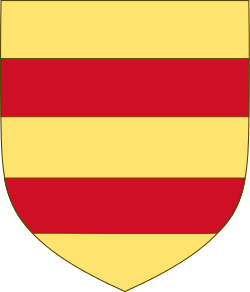
Coat of arms of the House of Oldenburg
· 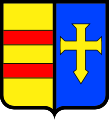
Coat of arms of the House of Schleswig-Holstein-Gottorp
· 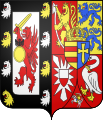
Coat of arms of the House of Romanov-Holstein-Gottorp
· 
Coat of arms of the Grand Dukes of Oldenburg (younger line Holstein-Gottorp)
· 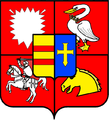
Coat of arms of the ducal house Schleswig-Holstein-Sonderburg-Glücksburg
· 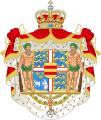
Coat of arms of the kings of Denmark
· .svg.png)
Coat of arms of the kings of Greece
· 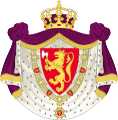
Coat of arms of the kings of Norway
Questions and Answers
Q: Which royal families does the House of Oldenburg belong to?
A: The House of Oldenburg belongs to the royal family of Greece, Denmark and the United Kingdom.
Q: Who are the descendants of King Constantine II and Queen of Denmark that belong to the House of Oldenburg?
A: King Constantine II and his descendants and Queen of Denmark and her descendants belong to the House of Oldenburg.
Q: Which title and royal families does Prince Philip belong to that are related to the House of Oldenburg?
A: Prince Philip, Duke of Edinburgh, Prince of Greece, Denmark and the United Kingdom and his descendants belong to the House of Oldenburg.
Q: Is the House of Oldenburg only related to the royal family of the United Kingdom?
A: No, the House of Oldenburg is related to the royal family of Greece and Denmark as well as the United Kingdom.
Q: Who founded the House of Oldenburg?
A: The House of Oldenburg was founded by Christian I of Denmark in 1448.
Q: What is the significance of the House of Oldenburg?
A: The House of Oldenburg is a historically significant royal house, having produced monarchs of Denmark, Norway, Greece, and Russia.
Q: Are there any famous members of the House of Oldenburg?
A: Yes, some famous members of the House of Oldenburg include Queen Margrethe II of Denmark and Grand Duchess Maria of Russia.
Search within the encyclopedia